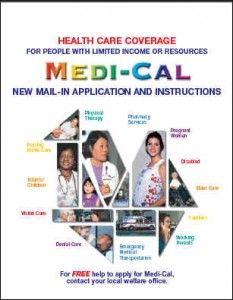Study: Med-Cal rolls could expand by 1 million
by John Seiler | March 20, 2014 2:45 pm
 [1]Although the California Budget Project sometimes gets into a tax-and-spend stance, their analyses often are based on solid numbers. That’s the case with their latest on Medi-Cal in Gov. Jerry Brown’s [2]budget proposal for fiscal year 2014-15, which begins on July 1.
[1]Although the California Budget Project sometimes gets into a tax-and-spend stance, their analyses often are based on solid numbers. That’s the case with their latest on Medi-Cal in Gov. Jerry Brown’s [2]budget proposal for fiscal year 2014-15, which begins on July 1.
The analysis found that Obamacare “is projected to increase Medi-Cal enrollment by well over 1 million and boost federal funding for the program by more than $10 billion through 2014-15.” Medi-Cal is California’s implementation of Medicaid.
According to the federal government’s own Medicaid site:
“Since the new law [Affordable Care Act] was enacted in March 2010, CMS [Centers for Medicare and Medicaid Services[3]] has worked together with state partners to identify key implementation priorities and provide the guidance needed to prepare for the significant changes to Medicaid and CHIP [Children’s Health Insurance Program] that will take effect on January 1, 2014. In particular, CMS has provided several forms of guidance and federal support for state efforts to develop new or upgrade existing eligibility systems.[4] “
Back to the CBP analysis: “The state projects that Medi-Cal enrollment will slightly exceed 10 million in 2014-15, with 1.5 million residents having enrolled due to California’s implementation of” the Affordable Care Act.
The means the Medi-Cal/Medicaid expansion will increase enrollment from 8.5 million Californians to about 10 million. So out of 38 million Californians, the increase will be from 31 percent to 38 percent.
It’s a symptom of what critics have called “a culture of welfare dependency[5].”
Politics
Politically, that means an expansion of clout for the Democratic Party in two ways. First, those receiving government benefits, especially at the lower end of the socio-economic scale, tend to vote Democratic. Second, expanding government programs means expanding the number of government workers to implement them. That means expanding the membership of government-worker unions, such as the Service Employees International Union[6], that orient strongly toward Democrats.
The state medical system will see an inrush of new federal dollars:
“The enrollment increase that is attributable to health care reform is projected to boost federal funding for Medi-Cal by $10.6 billion through June 2015. These funds will flow to doctors, clinics, and other health care providers in communities throughout the state. The vast majority of these federal dollars – more than $9 billion – will support services for Californians who enroll as part of the Medi-Cal expansion. The federal government will pay the full cost of providing health care services to these newly eligible enrollees through 2016, phasing down to a still-high 90 percent of the cost by 2020.”
Moreover, California’s general fund actually will see “a net decrease in … costs totaling nearly $900 million through June 2015.” That’s basically because the feds will be taking over some of what the state used to do.
Of course, there’s a cost. The money has to come from somewhere. CBP notes: “However, these gains coincide with the state’s 10 percent cut to Medi-Cal provider payments, which could hinder access to care.” That is, doctors will leave the system because it doesn’t pay them enough.
Indeed, just yesterday the Daily Caller reported[7]:
“In California, low reimbursement rates have led almost seven out of 10 physicians to reject[8] exchange insurance plans. Six out of 10 doctors nationwide expect[9] their colleagues to retire earlier due to the health care law; 75 percent of all physicians (and 81 percent of the most highly trained, surgeons) think the best of the nation’s youth won’t go into medicine as a result.”
It’s Econ. 101: Increase the demand for a service while reducing the remuneration, and shortages are inevitable.
- [Image]: http://calwatchdog.com/wp-content/uploads/2014/03/Medi-Cal-poster.jpg
- their latest on Medi-Cal in Gov. Jerry Brown’s : http://cbp.org/pdfs/2014/140320_Medi-Cal_Governor_Proposed_Budget_BB.pdf
- Centers for Medicare and Medicaid Services: http://www.cms.gov/
- eligibility systems.: http://www.medicaid.gov/AffordableCareAct/Provisions/Information-Technology-Systems-and-Data.html
- a culture of welfare dependency: http://www.cnn.com/2012/09/21/opinion/spalding-welfare-state-dependency/
- Service Employees International Union: http://www.seiu.org/
- Daily Caller reported: http://dailycaller.com/2014/03/19/american-medical-association-obamacare-sticks-doctors-with-unpaid-bills/
- reject: http://washingtonexaminer.com/exography-survey-finds-doctors-rebelling-against-obamacare-famous-hospitals-declining-to-join/article/2539830
- expect: http://www.cato.org/publications/commentary/obamacares-bitter-pill-doctors
Source URL: https://calwatchdog.com/2014/03/20/study-med-cal-rolls-could-expand-by-1-million/